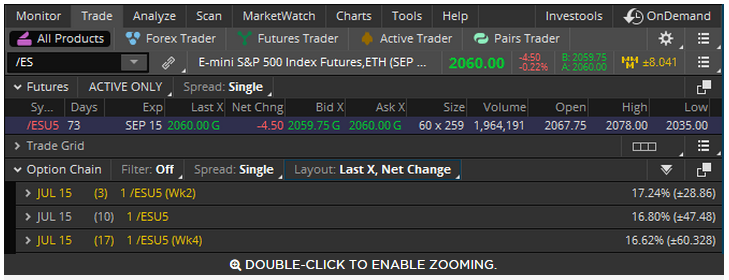Check That Expiration Date
The first thing to remember, and perhaps the most important, is that a futures option is a contract based on another contract (the future itself). Unlike equities, futures have a discrete expiration date (also known as a delivery date). At any given time a futures root, say "/ES" for example, could have several different actual futures contracts expiring at different times, such as "/ESU5", "/ESZ5", and "/ESM6". Every futures option gives you the right or obligation to buy or sell one of these specific futures contracts, so it's critical to keep track of them.Oil Drums On Your Front Porch?
Okay, we're making a little joke about commodities delivery. But, seriously, product delivery comes into play with futures options. Your second point to consider is the different standard deliverable for a futures option (i.e., what the option contract delivers on exercise or assignment). On the upside, non-standard futures option deliverables essentially do not exist. All futures options available at TD Ameritrade have the same deliverable: a single futures contract per futures options contract, as opposed to an equity option, which typically has a deliverable of 100 shares. However, futures options often have more or different available expirations than your standard optionable equity, including some end-of-week and end-of-month expirations. Pay close attention to the option series' header bar, which contains all its expiration and specification data (figure 1). FIGURE 1: RESPECT THE CALENDAR. Following expiration closely can be critical to successful trading in options futures. The good news is that the info is there if you know where to look. For instance, once you pull up a futures contract options chain, you'll see a series of tickers (in our example: /ESUS) including any non-standard expirations (Wk2, Wk4, and so on). To the far left of that ticker, you'll find the series' expiration, followed in parentheses by the number of days left until expiration. And at the far right, the percentage reading shows the implied volatility of the contract, and in parentheses, the implied price move on the underlying contract. Chart source: TD Ameritrade's thinkorswim® platform. For illustrative purposes only. Past performance does not guarantee future results.
FIGURE 1: RESPECT THE CALENDAR. Following expiration closely can be critical to successful trading in options futures. The good news is that the info is there if you know where to look. For instance, once you pull up a futures contract options chain, you'll see a series of tickers (in our example: /ESUS) including any non-standard expirations (Wk2, Wk4, and so on). To the far left of that ticker, you'll find the series' expiration, followed in parentheses by the number of days left until expiration. And at the far right, the percentage reading shows the implied volatility of the contract, and in parentheses, the implied price move on the underlying contract. Chart source: TD Ameritrade's thinkorswim® platform. For illustrative purposes only. Past performance does not guarantee future results.
Cushion Required
Finally, the margin requirements for futures options can be considerably different from those for standard options—even though the concepts of price, time, and volatility all still apply. Margin is the deposit required as security on a brokerage account. Unlike equity options in a regular margin, or "Reg-T," account, options on futures are evaluated on a "potential risk" basis. That means your overall position for an underlying future (and all associated options) is stress-tested against several different sets of potential price and volatility movements to determine the margin requirement for the position you currently hold. Adding to or removing from that position will change that requirement based on how those changes affect those potential moves. This is similar to, but not the same as, how margin is calculated in a risk-based equities account. Having a good grounding in risk analysis and options pricing theory is strongly recommended, particularly if the strategies you prefer utilize multiple different options contracts on a single future. Advanced traders and aspiring traders looking to up their game might consider these alternative products. The point is, these markets share similar vernacular, but some of the vital, underlying mechanics look a little different once you jump in.This piece was originally posted here by Chesley Spencer on August 6, 2015.
TD Ameritrade, Inc., member FINRA/SIPC. Commentary provided for educational purposes only. Past performance of a security, strategy, or index is no guarantee of future results or investment success. Inclusion of specific security names in this commentary does not constitute a recommendation from TD Ameritrade to buy, sell, or hold.
Options involve risks and are not suitable for all investors. Please read Characteristics and Risks of Standardized Options before investing. Supporting documentation for any claims, comparison, statistics, or other technical data will be supplied upon request.
The information is not intended to be investment advice and is for illustrative purposes only. Be sure to understand all risks involved with each strategy, including commission costs, before attempting to place any trade. Clients must consider all relevant risk factors, including their own personal financial situations, before trading.
© 2024 Benzinga.com. Benzinga does not provide investment advice. All rights reserved.
Comments
Trade confidently with insights and alerts from analyst ratings, free reports and breaking news that affects the stocks you care about.